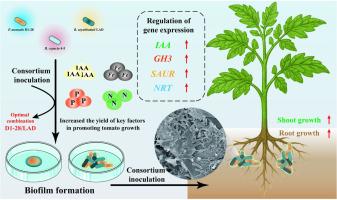Synergistic interaction in mixed pant growth promoting rhizobacteria consortium enhances biofilm formation and rhizosphere colonization to promote tomato (Solanum lycopersicum) growth
IF 4.2
2区 农林科学
Q1 HORTICULTURE
引用次数: 0
Abstract
While plant growth-promoting rhizobacteria (PGPR) consortia show enhanced benefits over single strains, the systematic design of functionally complementary synthetic communities and their synergistic mechanisms through biofilm-mediated root colonization remain poorly explored. This study aimed to screen and construct functionally complementary PGPR consortia, systematically evaluate their synergistic effects on biofilm formation in the tomato rhizosphere, and elucidate the underlying mechanisms regulating plant growth through enhanced root colonization and metabolic interactions. Three PGPR strains —Pantoea ananatis D1–28, Bacillus aryabhattai LAD, and Burkholderia cepacia 4–5—were selected for individual and combinatorial inoculation experiments. The results demonstrated that the D1–28/LAD combination exhibited significant synergistic advantages in both biofilm formation and plant growth promotion. This consortium markedly enhanced rhizosphere colonization and the synthesis of growth-promoting factors (such as N, P, siderophores, and IAA), thereby significantly improving tomato growth and up-regulating auxin biosynthesis and nitrogen transporter gene expression in roots. At an inoculum concentration of 106 cfu·mL−1, the fresh and dry weights of tomato shoots increased by 186.40 % and 278.57 %, respectively, while root fresh and dry weights increased by 327.62 % and 543.68 %. Plant height, root length, root surface area, and root volume increased by 117.19 %, 207.29 %, 531.36 %, and 525.69 %, respectively. This study provides theoretical insights into the role of microbial interactions in plant growth promotion and lays a technical foundation for the development of efficient and stable microbial biofertilizers, with promising applications in sustainable agriculture.

混合菌群生长中的协同作用促进了根际菌群的形成和根际定植,从而促进了番茄的生长
虽然促进植物生长的根瘤菌(PGPR)群落显示出比单一菌株更强的效益,但功能互补的合成群落的系统设计及其通过生物膜介导的根定植的协同机制仍未得到充分探索。本研究旨在筛选和构建功能互补的PGPR群体,系统评价它们对番茄根际生物膜形成的协同作用,并阐明通过增强根定植和代谢相互作用调节植物生长的潜在机制。选择3株PGPR -Pantoea ananatis D1-28、Bacillus aryabhattai LAD和Burkholderia cepacia 4 - 5进行单独和组合接种试验。结果表明,D1-28 /LAD组合在生物膜形成和促进植物生长方面均具有显著的协同优势。该联合体显著增强了番茄根际定植和生长促进因子(如N、P、铁载体和IAA)的合成,从而显著促进番茄生长,上调根系生长素生物合成和氮转运体基因表达。接种浓度为106 cfu·mL−1时,番茄新梢鲜重和干重分别增加186.40%和278.57%,根系鲜重和干重分别增加327.62%和543.68%。株高、根长、根表面积和根体积分别增加117.19%、207.29%、531.36%和525.69%。该研究为微生物相互作用在植物生长促进中的作用提供了理论见解,为开发高效、稳定的微生物生物肥料奠定了技术基础,在可持续农业中具有广阔的应用前景。
本文章由计算机程序翻译,如有差异,请以英文原文为准。
求助全文
约1分钟内获得全文
求助全文
来源期刊

Scientia Horticulturae
农林科学-园艺
CiteScore
8.60
自引率
4.70%
发文量
796
审稿时长
47 days
期刊介绍:
Scientia Horticulturae is an international journal publishing research related to horticultural crops. Articles in the journal deal with open or protected production of vegetables, fruits, edible fungi and ornamentals under temperate, subtropical and tropical conditions. Papers in related areas (biochemistry, micropropagation, soil science, plant breeding, plant physiology, phytopathology, etc.) are considered, if they contain information of direct significance to horticulture. Papers on the technical aspects of horticulture (engineering, crop processing, storage, transport etc.) are accepted for publication only if they relate directly to the living product. In the case of plantation crops, those yielding a product that may be used fresh (e.g. tropical vegetables, citrus, bananas, and other fruits) will be considered, while those papers describing the processing of the product (e.g. rubber, tobacco, and quinine) will not. The scope of the journal includes all horticultural crops but does not include speciality crops such as, medicinal crops or forestry crops, such as bamboo. Basic molecular studies without any direct application in horticulture will not be considered for this journal.
 求助内容:
求助内容: 应助结果提醒方式:
应助结果提醒方式:


